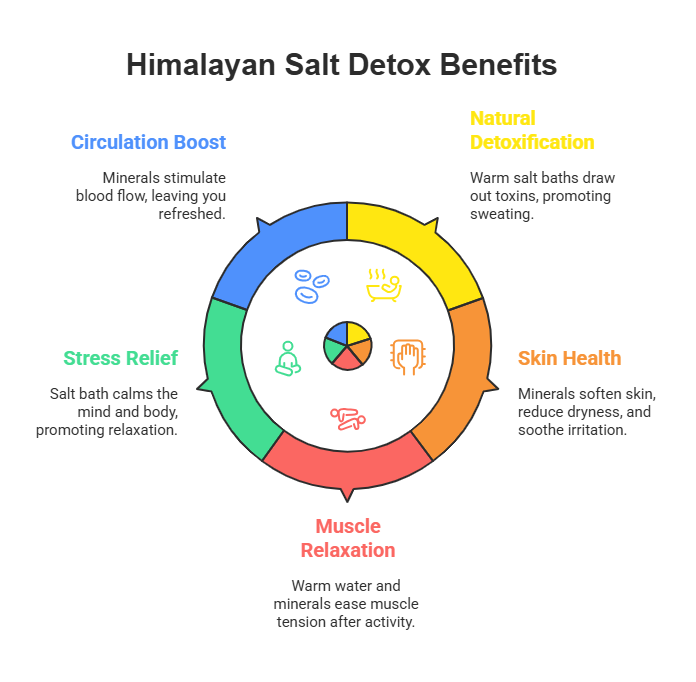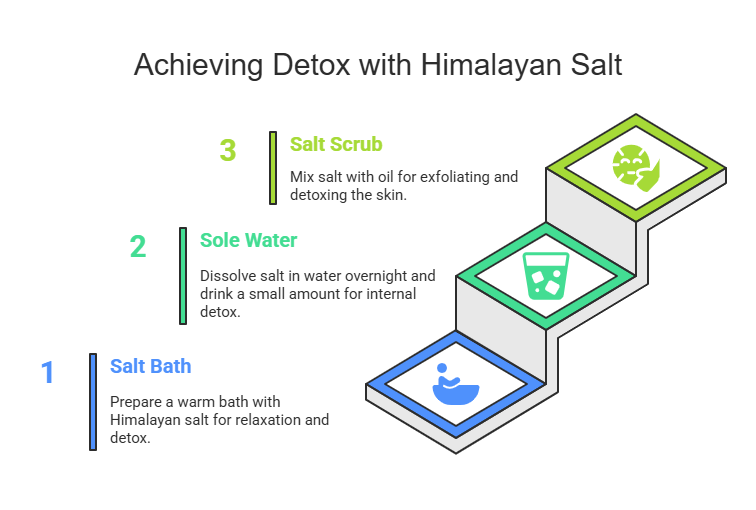The Ultimate Guide to Himalayan Salt Detox: Benefits, Methods, and How It Works
- Zayan Rauf

Himalayan pink salt is more than just a pretty seasoning for your food. It’s packed with natural minerals and has become a popular ingredient in wellness routines, especially for detoxing the body. In this guide, we’ll explore how Himalayan salt can help cleanse your system, relax your body, and support your overall well-being. Whether you’re soaking in a salt bath or sipping salt water, this guide will walk you through everything you need to know.
Table of Contents

Benefits of Himalayan Salt Detox
A Himalayan salt detox uses the natural minerals in pink salt to help your body release toxins. It can be done in different ways, like soaking in a salt bath, drinking a saltwater solution (called sole water), or using salt scrubs.
These methods are believed to help:
- Cleanse the skin
- Soothe sore muscles
- Improve circulation
- Support relaxation and stress relief
It’s a simple and natural way to give your body a gentle reset.
Himalayan Pink Salt Mineral Analysis
Many people turn to Himalayan salt detox methods for their relaxing and restorative effects. Here are some common benefits:
1. Natural Detoxification:
Warm salt baths may help draw out toxins through the skin while promoting healthy sweating.
2. Skin Health:
Minerals like magnesium and potassium can soften skin, reduce dryness, and soothe irritation.
3. Muscle Relaxation:
The warm water and minerals can ease muscle tension, making it great after a workout or stressful day.
4. Stress Relief:
Taking time for a salt bath or a relaxing scrub routine helps calm your mind and body.
5. Circulation Boost:
The minerals may stimulate better blood flow, leaving you feeling more energized and refreshed.
Read More: What is Himalayan Salt Soap
Popular Detox Methods with Himalayan Salt

Here are three simple ways you can try a Himalayan salt detox at home:
1. Salt Bath Detox
How to prepare a salt bath:
- Fill your bathtub with warm (not hot) water
- Add 1 to 2 cups of Himalayan pink salt
- Soak for 20 to 30 minutes
- Rinse off and rest afterward
This is one of the most popular ways to enjoy the detox effects of salt.
Tip: Use bath-grade salt to avoid irritation and make sure it’s pure.
You Can Also Check This Post: Side Effects Of Pink Himalayan Salt Bath What You Need To Know
2. Sole Water (Saltwater Drink)
Sole water is made by dissolving Himalayan salt in water and drinking a small amount each morning.
How to make sole water:
- Add Himalayan pink salt to a glass jar of water until it no longer dissolves
- Let it sit overnight
- In the morning, add 1 teaspoon of sole water to a glass of regular water and drink on an empty stomach
Note: Always consult your doctor before starting a saltwater detox, especially if you have any health conditions.
3. Salt Scrubs
Scrubs made with Himalayan salt are great for exfoliating and detoxing your skin.
DIY Recipe:
- Mix 1/2 cup of pink salt with coconut oil or olive oil
- Add a few drops of essential oil (optional)
- Gently scrub on your skin during a shower
Who Should Try a Himalayan Salt Detox?
Anyone looking for a natural way to unwind, refresh their skin, or support wellness can benefit from Himalayan salt detox methods. It’s especially popular among:
- Spa and wellness enthusiasts
- People with sore muscles
- Those looking to reduce stress naturally
Safety and Precautions
Himalayan salt detox is generally safe for most people, but it’s always smart to be cautious:
- Avoid if you have high blood pressure or kidney issues
- Pregnant women should consult a doctor before trying
- Don’t overuse salt baths or scrubs – 2-3 times a week is enough
Listen to your body, and stop if you feel any discomfort.
Final Thoughts
A Himalayan salt detox isn’t just a trend – it’s a natural, time-tested method that many people use to feel better inside and out. Whether you’re soaking in a warm salt bath, using a scrub, or trying sole water, these simple rituals can add a sense of calm and well-being to your life.
At Sobaan Salts, we supply high-quality, pure Himalayan pink salt that’s perfect for detox and wellness use. If you’re ready to start your journey, explore our detox-grade bath salts and wellness products.
Bath Spa Industry Growth: The global bath salts market—of which Himalayan salt products are a key segment—was valued at approximately USD 1.12 billion in 2023 and is projected to reach USD 1.86 billion by 2032, growing at a CAGR of 5.6%. This trend reflects increasing consumer interest in wellness and self-care rituals, including Himalayan salt baths. (Source: Data Intelo)
Share This Post
Article By

